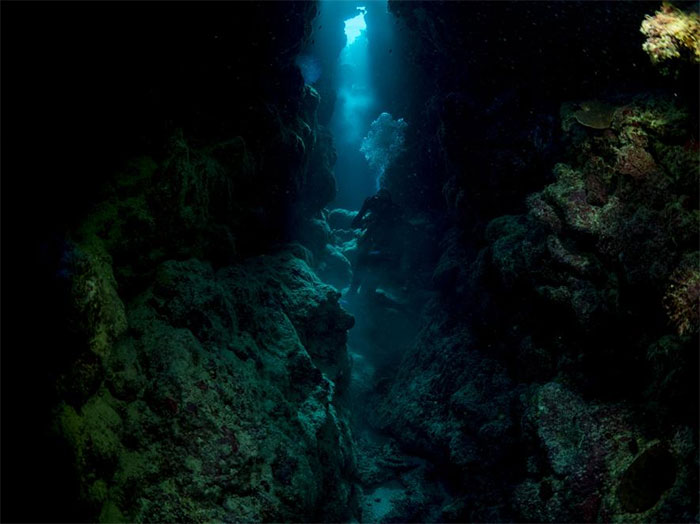Spawning coral: Great product of nature!
In the spawning season, under the full moon, the seabed layer of coral simultaneously releases billions of tiny gametes into the water, creating a magical pink "snowstorm" scene in the ocean.
To capture the sight of coral eggs , a certain photographer must wait until the full moon and the warmest sea. Along with a group of support divers, Michaela Skovranova (Australia) has seen firsthand the country (Australia).
In the breeding season, corals release billions of gametes into the water.
Every 15 minutes, they scooped up the water, thoroughly checking that it was time to spread the gametes. As soon as the first "egg" emerged, the divers gently left the boat. This scene only happens once a year - usually in December.
"Eggs" corals are released from each branch, round, tiny, usually pink. It would be more appropriate to call it "gametes" , because each particle includes eggs and sperm.
After a period of floating on the sea surface, eggs and coral sperm combine with each other, developing into larvae. They continue to drift until they turn into a single-celled protozoan (polyp) or join into "clusters" of young coral, then sink to the bottom of the sea, finding a place to stay.

Divers swim across the coral reef, find the appropriate observation place.
Every time the gamete disperses, the coral releases millions of cells. This quantity ensures that fertilization takes place smoothly. This coral's gametes can also be combined with other coral gametes, creating "hybrids".
In order not to shock the coral reef, divers must swim very carefully. If it is disturbed just before laying eggs, the coral will stop the process itself.

At the greatest time, the number of gametes is spread as much to the seabed as if there was a snowstorm.
Based on the moonlight alone, the sea is a desperate decision, but Skovranova has no other choice. He tried to observe with the naked eye instead of using a flashlight.
At the greatest time, the number of gametes is spread as much to the seabed as if there were snowstorms. As soon as they leave the "mother body" , coral spores have to compete with living space with zooplankton, even clown fish.
Important process to rescue corals
For marine conservationists, coral spawning season is the most important time of the year. They immediately proceeded to collect eggs and sperm for research and development of artificial corals.
This is the most effective solution to save bleached coral reefs all over the world today. Since 2015, Great Barrier has experienced the most terrible coral bleaching event, damaged to two thirds of the area.

Is artificial coral an alternative to today's bleached coral?
Although it is possible to use nematocyst cells in the tentacles to catch edema, corals mainly take nutrients from symbiosis with unicellular algae. But seawater pollution or global warming kills algae. And if the algae cannot grow, the coral will also perish.
With the current global warming situation, over the next 30 years, the sea could lose coral. As the foundation for the life of the ocean, the death of the coral also entails the extinction of many other organisms.

With the current global warming situation, over the next 30 years, the sea could lose coral.
Currently, Australian scientists at the Marine Science Institute of Australia are actively exploring and improving coral adaptability to high temperatures. The results show that they are completely capable.
Hoping that recovery will be carried out soon, let us continue to see the most wonderful wonder of nature.
- Australia implements a system to protect coral reefs
- The world's largest coral reefs face the risk of permanent wiping
- The world's largest coral reef is dying
- UNESCO warned of the Great Barrier Reef
- Rescue coral reefs worldwide
- The world's largest coral reef will not fall into danger
- The world's largest coral system is threatened
- Australia strives to protect the world's largest coral reef
- Discover coral rescue gene from starvation
- The beauty of the only natural wonder seen from the universe
- Securing the coral reef ecosystem in Phu Quoc
- The world's largest coral reef in breeding season
 Surprised: Fish that live in the dark ocean still see colors
Surprised: Fish that live in the dark ocean still see colors Japan suddenly caught the creature that caused the earthquake in the legend
Japan suddenly caught the creature that caused the earthquake in the legend A series of gray whale carcasses washed ashore on California's coast
A series of gray whale carcasses washed ashore on California's coast Compare the size of shark species in the world
Compare the size of shark species in the world Venomous snake species in Vietnam stands out with its 'white mourning head'
Venomous snake species in Vietnam stands out with its 'white mourning head'  Alarming coral bleaching phenomenon detected in the Red Sea
Alarming coral bleaching phenomenon detected in the Red Sea  Nearly 50% of tropical coral species are at risk of extinction
Nearly 50% of tropical coral species are at risk of extinction  World's largest coral reef discovered near Solomon Islands
World's largest coral reef discovered near Solomon Islands  Why does the phenomenon of dead and bleached coral occur in Con Dao?
Why does the phenomenon of dead and bleached coral occur in Con Dao?  Things to know about coral reefs around the world
Things to know about coral reefs around the world 